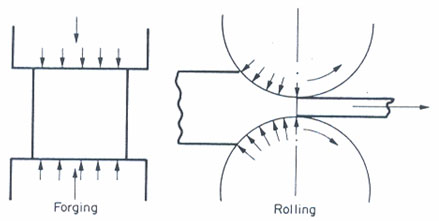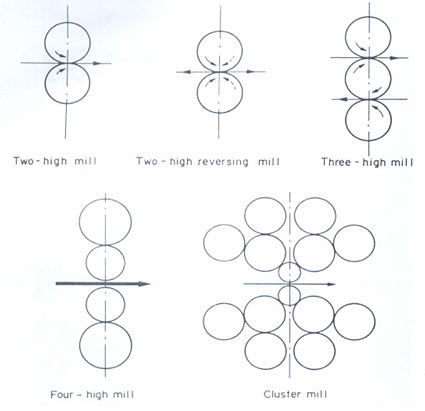| Shapes and bars are
normally available as Grades A, AH32, or AH36. Other
grades may be furnished by agreement between the
purchaser and the manufacturer.
When the steel is to be welded, it is presupposed
that a welding procedure suitable for the grade of
steel and intended use or service will be utilized.
Applicable Documents
- ASTM A6M Specification for General
Requirements for Delivery of Rolled Steel
Plates, Shapes, Sheet Piling, and Bars for
Structural Use
- ASTM A 370 Methods and Definitions for
Mechanical Testing of Steel Products
- ASTM E 112 Method of Determining the Average
Grain Size
Manufacture
The steel may be made by any of the following
processes: open-hearth, basic-oxygen,
electric-furnace, vacuum arc remelt (VAR), or
electroslag remelt (ESR).
Except for Grade A steel up to and including 12.5
mm in thickness, rimming-type steels shall not be
applied.
Grades AH32 and AH36 shapes through 426 lb/ft,
and plates up to 12.5 mm in thickness may be
semi-killed, in which case the 0.10 % minimum
silicon does not apply.
Besides few exceptions Grades D, DS, CS, E, DH32,
DH36, EH32, and EH36 shall be made using a fine
grain practice. For ordinary strength grades,
aluminum shall be used to obtain grain refinement.
For high strength grades, aluminum, vanadium, or
columbium (niobium) may be used for grain
refinement.
Grade D material 35 mm and under in thickness, at
the option of the manufacturer, may be semi-killed
and exempt from the fine austenitic grain size.
Heat Treatment
Plates in all thicknesses ordered to Grades CS and E
shall be normalized. Plates over 35 mm in thickness
ordered to Grade D shall be normalized. When Grade D
steel is furnished semi-killed, it shall be
normalized over 25 mm in thickness. Upon agreement
between the purchaser and the manufacturer, control
rolling of Grade D steel may be substituted for
normalizing, in which case impact tests are required
for each 25 tons [25 Mg] of material in the heat.
Plates in all thicknesses ordered to Grades EH32
and EH36 shall be normalized. Grades AH32, AH36,
DH32, and DH36 shall be normalized when so
specified. Upon agreement between the purchaser and
the manufacturer, control rolling of Grade DH may be
substituted for normalizing, in which case impact
tests are required on each plate.
In the case of shapes, the thicknesses referred
to are those of the flange.
Metallurgical Structure
Fine grain practice for ordinary strength grades
shall be met using aluminum. For higher strength
grades, aluminum, vanadium, or columbium may be used
as grain refining elements.
Grain size shall be determined on each heat by
the Mc-Quaid-Ehn Method of Method E 112. The grain
size so determined shall be No. 5 or finer in 70 %
of the area examined.
As an alternative to the McQuaid-Ehn test, a fine
grain practice requirement may be met by a minimum
acid-soluble aluminum content of 0.015 % or minimum
total aluminum content of 0.020 % for each heat.
For Grades DH32, DH36, EH32, and EH36 the fine
grain practice requirement may also be met by the
following:
- Minimum columbium (niobium) content of 0.020
% or minimum vanadium content of 0.050 % for
each heat, or
- When vanadium and aluminum are used in
combination, minimum vanadium content of 0.030 %
and minimum acid-soluble aluminum content of
0.010 % or minimum total aluminum content of
0.015%.
Mechanical Requirements
Tension Tests. Except as specified in the
following paragraphs the material as represented by
the test specimens shall conform to the prescribed
tensile requirements.
Unless a specific orientation is called for on
the purchase order, tension test specimens may be
taken parallel or transverse to the final direction
of rolling at the option of the steel manufacturer.
Shapes less than 645 mm2 in cross section, and
bars, other than flats, less than 12.5mm in
thickness or diameter need not be subjected to
tension tests by the manufacturer. For material
under 8 mm in thickness or diameter, a deduction
from the percentage of elongation in 200 mm of 1.25
percentage points shall be made for each decrease of
0.8 mm of the specified thickness or diameter below
8 mm.
Toughness Tests (material 50 mm and less
in thickness). Except as permitted bellow, Charpy
V-notch tests shall be made on Grade B material over
25 mm in thickness and on material of Grades D, E,
AH32, AH36, DH32, DH36, EH32, and EH36.
Toughness tests are not required: (a) on Grade D
normalized material made fully killed and having a
fine austenitic grain size, (b) on Grades AH32 and
AH36 when normalized, or when 12.5 mm or less in
thickness when treated with vanadium or columbium
(niobium) or 35 mm or less in thickness when treated
with aluminum, and (c) on Grades DH32 and DH36
material when normalized or when 12.5 mm or less in
thickness when treated with vanadium or columbium
(niobium) or less in thickness when treated with
aluminum, and on Grades DH32 and DH36 material when
normalized.
For plate material, when required, one set of
three impact specimens shall be made from the
thickest material in each 50 tons [45 Mg] of each
heat of Grades B, D, AH32, AH36, DH32, and DH36
steels and from each rolled product of normalized
Grades E, EH32, and EH36 steels. When heat testing
is called for, a set of three specimens shall be
tested for each 50 tons [45 Mg] of the same type of
product produced on the same mill from each heat of
steel. The set of impact specimens shall be taken
from different as-rolled or heat-treated pieces of
the heaviest gage produced. An as-rolled piece
refers to the product rolled from a slab, billet,
bloom, or directly from an ingot.
For flats, rounds, and shapes, one set of three
impact tests shall be taken from each 25 tons [25
Mg] of each heat for Grade E, EH32, or EH36 and,
when required, from each 50 tons [45 Mg] of each
heat of Grade B, D, AH32, AH36, DH32, or DH36
material. Where the maximum thickness or diameter of
various sections differs by 10 mm or more, one set
of impacts shall be made from both the thickest and
the thinnest material rolled regardless of the
weight represented.
The specimens for plates shall be taken from a
corner of the material and the specimens from shapes
shall be taken from the end of a shape at a point
one-third the distance from the outer edge of the
flange or leg to the web or heel of the shape.
Specimens for bars shall be in accordance with
Specification A 6M. The center longitudinal axis of
the specimens shall be located as near as practical
midway between the surface and the center of the
material and the length of the notch shall be
perpendicular to the rolled surface. Unless a
specific orientation is called for on the purchase
order, the longitudinal axis of the specimens may be
parallel or transverse to the final direction of
rolling of the material at the option of the steel
manufacturer.
Each impact test shall constitute the average
value of three specimens taken from a single test
location.
After heat treatment or reheat treatment a set of
three specimens shall be tested and evaluated in the
same manner as for the original material.
Toughness Tests (material over 50 mm
thick). Charpy V-notch tests are required for all
grades of steel over 50 mm thick, except for Grade A
that is produced killed, using a fine grain practice
and normalized. For plate material one set of three
impact specimens shall be made from the thickest
material in each 50 tons [45 Mg] of each heat of
Grades A, B, D, DS, AH32, AH36, DH32, and DH36, and
from each rolled product of Grades CS, E, EH32, and
EH36. For flats, rounds, and shapes, one set of
three impact tests shall be taken from each 25 tons
[25 Mg] of each heat for Grades CS, E, EH32, and
EH36, and from each 50 tons of each heat of Grades
A, B, D, DS, AH32, AH36, DH32, and DH36 material.
Rivet Steel and Rivets. For rivet steel a
sulfur print requirement shall be met when other
than killed or semi-killed steel is applied, in
order to confirm that its core is free of
concentrations of sulfur segregates and other
nonmetallic substances. Test specimens for rivet
bars that have been cold drawn shall be normalized
before testing. Finished rivets are to be selected
as sample specimens from each diameter and tested
hot and cold by bending and crushing in the
following manner: the shank must stand being doubled
together cold, and the head being flattened hot to a
diameter 2.5 times the diameter of the shank, both
without fracture.
 beck
to top beck
to top
|

